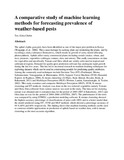A comparative study of machine learning methods for forecasting prevalence of weather-based pests
Abstract
The aphid (Aphis gossypii), have been identified as one of the major pest problem in
Kenya (Waiganjo, et al., 2006). They cause damage by sucking plant sap weakening the
plants, and by excreting a sticky substance (honeydew), which results in growth of sooty
mould affecting photosynthesis. Aphids affect many commercial plants including cereals
(maize, wheat, and rice), potatoes, vegetables (cabbages, tomato, okra, and onion).
This study concentrates on data for vegetables and specifically Tomato and Okra which
are widely cultivated in tropical and subtropical regions.
Demand for quality pest-prediction software has undergone rapid growth during the last
few years. This has led to increased research in machine learning techniques for
exploring datasets which can be used in constructing models for predicting quality
attributes. Among the commonly used techniques include Decision Tree (DT)
(Pratheepal, Meena, Subramaniam, Venugopalan, & Bheemanna, 2010), Support Vector
Machine (SVM) (Kaundal, Kapoor, & Raghaya, 2006), K-means clustering (Al-Hiary,
Bani-Ahmad, Reyalat, Braik, & Rahamneh, 2011) and Multilayer Perceptron (MLP)
(Worner, Lankin, Samarasinghe, & Teulon, 2002). This study examines and compares
Multilayer Perceptron (MLP), SVM, K-means clustering and DT methods.
Analysis was done on the two selected vegetables namely Tomato and Okra. Data
collected from various sources was used in the study. The data set for studying tomato
was obtained and it contained data for the period of 2005-2007 (Chakraborty, 2011) and
Okra data set was for the period of 2004-2006 (ANITHA, 2007).
The performance of the tools was compared by using DTREG, a prediction modeling
software. K-means clustering showed the highest accuracy percentage of classifications
of pests with 100% and is a better model than the model predicted using DT , SVM and
MLP methods which showed a percentage accuracy of 94 %,60%,and 60% respectively.
The finding shows that machine learning methods can be used to construct reliable
applications in prediction of aphids based on weather data, with k-means clustering as the
most accurate algorithm.
Citation
Masters of science in computer sciencePublisher
University of Nairobi School of Computing and Informatics

